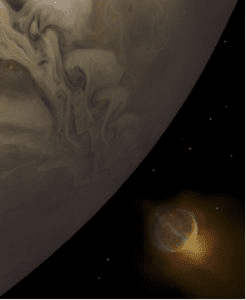If we ever establish colonies on Jupiter’s four big moons, those living there will enjoy looking up. Besides the sight of Jupiter hanging in the sky from the planet-facing side of each moon, and views of every other moon, big and small, there will be beautiful aurorae to watch. Surprisingly, this is something we have discovered using one of the largest telescopes on Earth, not any of the spacecraft that have visited the system.
Jupiter’s mighty auroras are well known, despite the diminution of the solar wind at its location, they even appear to have curious effects on the giant planet’s temperature balance. The UV components of the moons’ aurorae have been studied before, despite their thin atmospheres and lack of magnetic fields of their own. Now, the research has been extended into the visible spectrum and expanded what we know about the atmospheres these worlds do have.
Twin papers in The Planetary Science Journal are based on results collected with the High-Resolution Echelle Spectrometer (HIRES) at the Keck Observatory, and spectrographs on other large telescopes. It is the first time optical aurora have been studied on three of the moons.
There is no hope of seeing the aurorae when the moons are in daylight, but the Earth is too close to the Sun to observe their far sides. Instead, the team watched the Moons when Jupiter blocked the sunlight. “These observations are tricky because in Jupiter’s shadow the moons are nearly invisible. The light emitted by their faint aurorae is the only confirmation that we’ve even pointed the telescope at the right place,” Dr Katherine de Kleer of Caltech said in a statement.
Earth’s aurorae are caused by the planet’s magnetic field channeling charged particles toward the poles, where collisions with gases in the atmosphere produce the colors we see. Those colors depend on the specific gasses the particles interact with.
Io is where things get most interesting, being not only the moon closest to the heart of the magnetic field, but with an atmosphere constantly refreshed by volcanic plumes hundreds of kilometers high. The result is yellow-orange glow like sodium streetlights, mixed with some red and green from oxygen.
The aurorae vary depending on each moon’s relationship at the time to Jupiter’s tilted magnetic field and its shadow. “Io’s sodium becomes very faint within 15 minutes of entering Jupiter’s shadow, but it takes several hours to recover after it emerges into sunlight,” said Boston University’s Professor Carl Schmidt. The oxygen component is much more stable, and given the shortness of Io’s orbit, this is dominant much of the time.
Artist’s impression of the mixed sodium, potassium and oxygen aurorae as Io enters Jupiter’s shadow, with the sodium component nearly ending within 15 minutes. Image Credit: Chris Faust
The thin atmospheres of Europa and Ganymede are still sufficient to produce aurorae, but they are deep red rather than Earth’s predominant green.
These three all have some near-infrared aurorae, invisible to our eyes but detectable by the telescopes, caused by potassium on Io and oxygen on the next two.
“The brightness of the different colors of aurora tell us what these moons’ atmospheres are likely made up of,” said de Kleer. “We find that molecular oxygen, just like what we breathe here on Earth, is likely the main constituent of the icy moon atmospheres.”
The findings are at least as significant for the colors that were not detected. The studies suggest barely a fifth of Europa’s atmosphere is water vapor, despite past detection of geysers thought to be from its internal ocean. The team could only put an upper limit on the water in Ganymede’s atmosphere, despite it also being suspected of having a subsurface ocean, while Callisto’s aurora is so faint its composition was hard to determine. These results conflict with the UV surveys, which found much more water. The papers suggest the movement into shadow may change the composition of Europa and Ganymede’s atmospheres as well.
The papers with de Kleer and Schmidt as respective first authors are both published open access in The Planetary Science Journal.
Source Link: New Auroras Found Lighting Up Atmospheres Of Jupiter’s Four Biggest Moons
